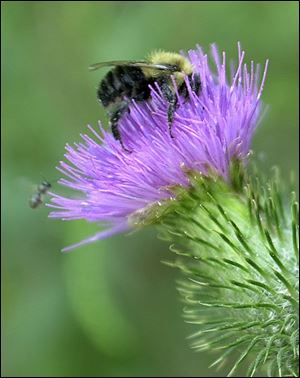
Keep insect stings out of your summer
6/12/2002With a mild winter and a very wet spring, we are bound to be swarmed with mosquitoes. Other stinging insects are emerging from the flora as well. Yellow jackets, hornets, and bees are great for the environment, but they can pack a painful poke. Here's how to identify some common stinging insects you may find outside.
Yellow jackets and hornets
Yellow jackets live in underground burrows and make paper nests. They have yellow and black markings much like hornets and wasps, but are a little smaller and fatter. Yellow jackets, don't have hair like honeybees, and don't have flattened hairy hind legs like bees. They can grow to about an inch long.

A bumblebee searches for nectar on a thistle at Swan Creek preserve Metropark.
Hornets resemble yellow jackets, but usually have white markings on their faces and abdomens. They build gray or tan paperlike nests that are about the size of a football or soccer ball. Sometimes they live in the ground, but their nests are usually in trees, shrubs, or in protected places in or around houses such as attics, hollow walls, flooring, eaves, porches, and sheds.
Bumblebees
Bumblebees are yellow and black, but they are bigger, fatter and hairy, setting them apart from other stinging insects. They can grow over an inch long. The queen and her workers can deliver a painful sting. Their nests look like a honeycomb and can be found in the ground, old stumps, abandoned mattresses, old bales of straw or hay in barns, corn husks in corncribs, along foundations, or almost anywhere they can find shelter near open grasslands.
Bumblebees are extremely important pollinators of certain kinds of clover such as red clover because they have long tongues. Some of their favorite flowers are sunflowers, thistles, nettles, roses, and partridge peas, as well as clovers.
Sweat bees
If you are a busy gardener, you have probably seen these little bees hovering near your sweaty brow. Sweat bees live in small tunnels they dig in loose soil. Less than an inch long, sweat bees have yellow, red, or metallic markings. These bees pollinate most flowers, gathering pollen and nectar to feed their young.
Traps and controls
Commercial stinging-insect traps are available at home and garden centers. You can also make your own. Here's how:
The insects will be attracted to the sweet liquid in the container and drown. Change the trap every two or three days in the summer. Traps will usually work in a 15-square-foot area. If traps aren't working, Ohio State University scientists recommend using carbaryl 5 percent dust, diazinon RTU, or pyrethroid RTU for above ground nests. You can put the dust chemicals in an empty dish detergent bottle and squirt the dry chemicals on the nest opening. Apply diazinon or RTU on below-ground nests.
Nests
Never touch a nest. You can call an expert to remove it for you or spray it with one of many name brand insecticides on the market. Spray the nest in the late evening while the insects are inactive. Look for sprays or dusting products that include chemicals such as resmethrin, pyrethrins, carbaryl, or bendiocarb. Always follow the directions on the product's label carefully. You will be able to safely remove the nest in a day or two after all of the insects are dead.
Getting stung
Almost 100 deaths are reported each year from insect-sting reactions, according to Ohio State University.
Yellow jackets and hornets have lancelike stingers, making them easier to remove. But that means the insects can remove the stingers and sting you over and over. Gently brush these insects away from you and slowly move away from their path.
Bees have barbed stingers, and leave the stingers and venomous sacs in your skin. If you remove the stinger quickly, it won't hurt as much. Scrape it off sideways with your fingernail.
A normal reaction to a sting is a sharp pain, with the affected area turning red and hurting for a while. A large, local reaction will be more painful. The affected area may itch for a few days.
But if you are severely allergic to insect venom, you might feel dizzy, weak, and sick to your stomach after being stung. People with symptoms such as diarrhea, itchy eyes, coughing, hives, abnormal swelling, or vomiting need immediate medical care.
If you get stung, try putting ice on the area to ease the pain. A paste of baking soda or meat tenderizer can reduce the pain and swelling because their ingredients break down the insect's sting fluid. People who are allergic to a sting may need more treatment and should see a doctor. Remember, if these predators aren't bothering you, don't bother them. They are part of the ecological balance in your backyard and neighborhood.